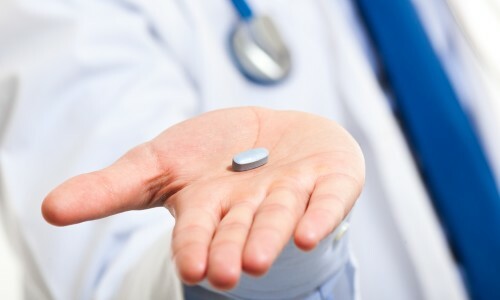Most of the specialists classify serotonin syndrome as one of the manifestations of nerve overexertion. The patient to whom this diagnosis was made, most often goes to the pharmacy in search of a powerful sedative. But sedatives can not fully implement the therapy presented pathology. Many doctors insist on their rightness and do not want to inform the patient about the possible consequences of such "treatment".Meanwhile, often under the guise of a serotonin syndrome, more dangerous pathological conditions are masked than trivial overwork, nervous breakdown or depression. Therefore, it makes sense to talk about what it is, how it manifests itself and what can lead to incorrect treatment or complete disregard of the problem.
What is this?

Serotonin syndrome is a pathological condition of the body resulting from the use of drugs or drugs that directly affect the production of a substance such as serotonin. In some cases, when the symptoms of serotonin syndrome are ignored, the patient may die.
Reasons and statistics
The main reason for the onset of the syndrome is the failure to comply with the recommended dosages for the combinatorial use of drug preparations of different groups( eg, antidepressant inhibitor type, biologically active substances).The second reason is an overdose of narcotic substances.
The first information about the serotonin syndrome was registered in America in the 60th year of the last century. Doctors described the symptoms of this pathological condition in people who were treated for depression with the help of antidepressants. Somewhat later, it was possible to establish a direct link between the onset of the syndrome and the use of drug preparations of a different spectrum of action simultaneously with antidepressants. It was proved that serotonin syndrome can develop even after a single administration of the latter.
It is interesting that there is no reliable statistical data on the incidence of this pathological condition. More precisely, some information in the official medical documentation is still available, but they can not fully reflect the real picture. This situation is facilitated by the following reasons:

- Not all patients who report symptoms of serotonin syndrome, turn to specialists.
- Not in all cases, the symptomatology of the syndrome is recognized by doctors as a reason for stating the presented diagnosis.
- There is no laboratory evidence of the pathological reaction of the body because most often the concentration of certain substances( included in the drug) does not exceed normal values. And at the same time, an elevated level of these substances in the blood does not always provoke the development of serotonin syndrome.
If we talk about serotonin syndrome, which was triggered by the use of narcotic drugs, then it is not possible to track the statistics at all. After all, the symptoms of the syndrome in the state of drug intoxication are perceived as narcotic euphoria.
The development mechanism of
Pathology is the result of an excess of serotonin in the synaptic cleft. Excess serotonin can occur due to blockade of the activity of enzymes responsible for the cleavage of this substance, disruption of the return return, excessive sensitivity of serotonin receptors or in the increased synthesis of serotonin. Such changes in the body provoke the use of drugs that affect serotonin metabolism. Disruptions in the regulatory processes in which serotonin takes part are manifested in disturbances in the proper functioning of most body systems.
Symptoms of
Symptoms of a pathology occur in a short time. In half of the patients, the symptoms of the syndrome appear already within two hours after taking medications that provoked the disturbances of serotonin metabolism. In a quarter of patients negative reactions of the organism are noted in the first day, and in 25% - during the second or third day.

Experts agree to divide all symptoms of the manifestation of serotonin syndrome into three types:
- mental changes,
- disorders, associated with the vegetative system,
- changes in neuromuscular communication.
Mental changes
Changes in the psycho-emotional state are the very first sign of the development of the disease. These changes include:
- Excessive emotional arousal.
- Increased anxiety and a sense of fear, which are manifested in motor anxiety( they say that a person "rushes").Or, on the contrary, a feeling of inexplicable euphoria and joy.
- Infinite uncontrolled speech stream.
- Delirium and hallucinations.
- Impaired consciousness.
The severity of the symptoms is directly related to the severity of the pathology. Small dosages of drugs or a single use of incompatible drugs leads to emotional and motor excitation without hallucinations or disorders in consciousness. Often this is perceived as an exacerbation of the underlying disease, in connection with which medications were prescribed, so their reception does not stop. As a result, more serious mental disorders develop. If, after starting treatment, a person notices the uncharacteristic side effects of prescribed medications, and the main problem continues to show itself clearly, this is a serious reason for contacting a specialist.
Vegetative disorders

The severity of disorders in the functioning of the vegetative system also depends on the severity of the syndrome. Vegetative disorders include such conditions as:
- a sharp increase in the number of heartbeats( tachycardia),
- severe head pain,
- sensation of chills,
- increased sweating,
- rise in body temperature to critical markers,
- abnormal lacrimation,
- increase in blood pressure,
- dryness of the oral mucosa,
- disorders in the digestive tract in the form of diarrhea, nausea, vomiting, flatulence, stomach pain.
Neuromuscular junction changes
Neuromuscular symptoms are a combination of a group of signs of the manifestation of serotonin syndrome that result from the disruption of the process of nerve impulse transmission from neurons to muscle fiber cells:
- Increased reflexes of tendons. Expression manifests itself on the lower limbs. Excessive muscle tone. Often provokes muscle rigidity.
- Short-term spontaneous non-rhythmical contractions of various separate or muscle groups.
- Tremor of the upper and lower extremities.
- Spontaneous movements of the vibrational nature of eyeballs.
- Disturbances of motor coordination.
- Slurred speech.
- Epileptic attacks.

Complete clinical picture of the disease is infrequent. In most cases, patients have one or two symptoms from each group.
The main insidiousness of serotonin syndrome is that the symptomatology of its manifestation at the initial stages of development is not bright, so many patients do not rush to the doctor. But it is important to understand that in the case of continuation of the introduction of drugs provoking the syndrome, the time interval between the appearance of the first signs of pathology and the condition requiring resuscitation can be only a couple of hours! Therefore, it is necessary to closely monitor the reaction of the body to new medicines and, with the slightest change, contact specialists.



